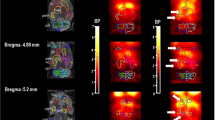Abstract
These experiments sought to determine whether dopamine (DA) could reverse the depressive effects of α-methyl-p-tyrosine (AMPT) on a conditioned avoidance response (CAR). Rats were randomly allocated to shocked groups (CAR-trained) and non-shocked (CAR-naive) groups. The CAR-trained rats, conditioned to avoid an electric shock, were administered AMPT (150 mg/kg at-24 h and 50 mg/kg at-1 h, both IP), nialamide (80 mg/kg IP at-1 h) and saline (1 μl) or DA (5 or 10 μg/μl, dissolved in 1 μl saline, at time 0) directly into the nucleus accumbens. The rats were then tested for CAR at 0.5, 1, 2, 3, 4, 8, 12, 24 and 48 h. The CAR-naive rats, conditioned to the behavioural environment without electric shock being presented, were administered AMPT, nialamide and DA or saline as above. Both doses of DA antagonised the AMPT-induced suppression of the CAR in the CAR-trained rats, reaching a maximum 2–4 h after its local application. In the CAR-naive rats, DA produced a ‘pseudo-CAR’ that lasted about 4 h, but which completely disappeared at 8 h when the DA effect had worn off. These CAR-naive rats did not learn a CAR under the influence of DA. In a third group of rats, DA produced locomotor activation which, in its time course, resembled the effect of DA on CAR. It is concluded that the ability of DA to antagonise AMPT-induced depression of CAR is, in all likelihood, dependent upon DA-induced locomotor excitation, rather than upon an effect of DA on associative learning.
Similar content being viewed by others
References
Ahlenius S (1973) Inhibition of catecholamine synthesis and conditioned avoidance acquisition. Pharmacol Biochem Behav 1:347–350
Ahlenius S (1974a) Effects of L-dopa on conditioned avoidance responding after behavioural suppression by α-methyltyrosine or reserpine in mice. Neuropharmacology 13:729–739
Ahlenius S (1974b) Effects of low and high doses of L-dopa on the tetrabenazine or α-methyltyrosine-induced suppression of behaviour in a successive discrimination task. Psychopharmacologia 39:199–212
Ahlenius S, Andén NE, Engel J (1971) Importance of catecholamine release by nerve impulses for free operant behavior. Physiol Behav 7:931–934
Ahlenius S, Engel J (1971) Behavioral effects of haloperidol after tyrosine hydroxylase inhibition. Eur J Pharmacol 15:187–192
Ahlenius S, Engel J (1973) Antagonism by Dl-threo-DOPS of the suppression of a conditioned avoidance response induced by a dopamine-β-hydroxylase inhibitor. J Neural Transm 34:267–277
Andén NE, Jackson DM (1975) Locomotor activity stimulation in rats produced by DA in the nucleus accumbens: Potentiation by caffeine. J Pharm Pharmacol 27:666–670
Björck A (1967) Solving linear least-squares problems by Gram-Schmidt orthogonalisation. Bit 7:1–21
Bock RD (1975) Multivariate statistical methods in behavioral research. McGraw Hill, New York
Corrodi H, Hanson LCF (1966) Central effects of an inhibitor of tyrosine hydroxylase Psychopharmacologia 10:116–125
Courvoisier S, Fournel J, Ducrot R, Kolsky M, Koetschet P (1953) Propriétés pharmacodynamiques de chlorhydrate de chloro-3-(dimethylamine-3-propyl)-10-phenothiazine 4650RP. Arch Int Pharmacodyn Ther 92:305–361
Gregory K (1968) The action of the drug prenylamine (Segontin) on exploratory activity and aversive learning in a selected strain of rats. Psychopharmacologia 13:22–28
Hanson LCF (1965) The disruption of conditioned avoidance response following selective depletion of brain catecholamines. Psychopharmacologia 8:100–110
Hummel TJ, Sligo JR (1971) Empirical comparison of univariate and multivariate analysis of variance procedures. Psychol Bull 76:49–57
Jackson DM, Ahlenius S, Andén NE, Engel J (1977) Antagonism by locally applied dopamine into the nucleus accumbens or the corpus striatum of α-methyltyrosine-induced disruption of conditioned avoidance behaviour. J Neural Transm 41:231–239
Jackson DM, Andén NE, Dahlström A (1975) A functional effect of dopamine in the nucleus accumbens and in some other dopaminerich parts of the rat brain. Psychopharmacologia 45:139–149
John ER, Killam KF (1959) Electrophysiological correlates of avoidance conditioning in the cat. J Pharmacol Exp Ther 125:252–274
König JFR, Klippel RA (1963) The rat brain: A stereotaxic atlas of the forebrain and lower parts of the brain stem. Krieger, New York
Kulkarni AS (1968) Facilitation of instrumental avoidance learning by amphetamine: An analysis. Psychopharmacologia 13:418–425
Kulkarni AS, Job WM (1967) Facilitation of avoidance learning by d-amphetamine. Life Sci 6:1579–1587
Lenard LG, Beer B (1975) 6-Hydroxydopamine and avoidance: Possible role of response suppression. Pharmacol Biochem Behav 3:873–878
Moore KE (1965) Effects of α-methyl-p-tyrosine (αMpT) on brain catecholamine depletion and conditioned behavior. Pharmacologist 7:170
Pijnenburg AJJ, Woodruff GN, van Rossum JM (1973) Ergometrine-induced locomotor activity following intracerebral injection into the nucleus accumbens. Brain Res 59:289–302
Seiden LS, Carlsson A (1963) Temporary and partial antagonism by L-dopa of reserpine-induced suppression of a CAR. Psychopharmacologia 4:418–423
Author information
Authors and Affiliations
Rights and permissions
About this article
Cite this article
Bracs, P.U., Jackson, D.M. & Gregory, P. α-Methyl-p-tyrosine inhibition of a conditioned avoidance response: Reversal by dopamine applied to the nucleus accumbens. Psychopharmacology 77, 159–163 (1982). https://doi.org/10.1007/BF00431940
Received:
Issue Date:
DOI: https://doi.org/10.1007/BF00431940




